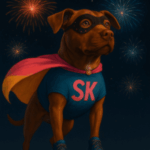Copy of Shelter Dog Training - Complete Course
-
Section 1: OVERVIEW & FUNDAMENTALS
Welcome Lectures16 Video Topics-
Course Agreement & Course Manual
-
Introduction & Mission Statement
-
The Genetic Makeup of the Dog
-
Pet Dogs vs Shelter Dogs
-
Why Dogs End Up in Shelters
-
Understanding Breeds
-
Shelter Mix Breakdown
-
Mitigating Injuries
-
Blueprint of Dog Drives
-
Using Treats / Food As a Reward
-
Engagement Training
-
Training Methods
-
Canine Body Language
-
Spatial Pressure
-
Correction vs Punishment Intro
-
Understanding Playgroup Basics
-
Course Agreement & Course Manual
-
Section 2: Introduction / TheoryCommunicating with Dogs1 Video Topic
-
Understanding the Genetic Makeup of the Dog1 Video Topic
-
What Makes Shelter Dogs Different2 Video Topics
-
The Anatomy of a Dog1 Quiz
-
Section 3: GETTING STARTEDThe Various Groups / Breeds of Dogs4 Video Topics
-
The Shelter Mix Breakdown1 Video Topic
-
The Blueprint of the Dog1 Video Topic
-
Anthropomorphism1 Video Topic|1 Quiz
-
Section 4: SafetyMitigating Injuries2 Video Topics
-
Canine Body Language1 Video Topic
-
Spatial Pressure1 Video Topic
-
Radius of Temperament1 Video Topic|1 Quiz
-
Section 5: The BASICS OF TRAININGBonding Through Training2 Video Topics
-
Luring and Shaping Behaviors5 Video Topics
-
Engagement Training4 Video Topics
-
Using Food as a Reward1 Video Topic
-
Different Training Methods1 Video Topic|1 Quiz
-
Section 6: UNDERSTANDING DOGS THROUGH TRAININGEngagement Training Continued5 Video Topics
-
Recall Training5 Video Topics
-
Corrections vs Punishment1 Video Topic
-
Long Line Training5 Video Topics|1 Quiz
-
SECTION 7: USING THE LEASH & LONG LINEHow to Use a Leash7 Video Topics
-
Long Line Training - Part 26 Video Topics|1 Quiz
-
Section 8: HOW TRAINING SAVES LIVESThe Canine Good Citizen5 Video Topics
-
Basic Obedience4 Video Topics
-
Teaching the Leave It Command4 Video Topics
-
The Place Command3 Video Topics|1 Quiz
-
Section 9: Building ConfidenceBuilding Confidence3 Video Topics
-
Touch Sensitivity1 Video Topic
-
Fear Aggression1 Video Topic
-
Progressive Desensitization1 Video Topic|1 Quiz
-
Section 10: Getting Dogs Around other DogsDog to Dog Introductions10 Video Topics
-
Leash Dropping1 Video Topic|1 Quiz
-
Section 11: Playgroup TrainingWhat is a Structured and Managed Playgroup2 Video Topics
-
Beginning and Structuring a Playgroup4 Video Topics
-
What Makes Playgrounds Safe vs Dangerous3 Video Topics
-
How Playgroups Benefit Dogs in Shelters2 Video Topics|1 Quiz
-
Section 12: Behavior ObservationsUnderstanding What You See5 Video Topics
-
Defining Behaviors3 Video Topics
-
Reading Dogs3 Video Topics|1 Quiz
-
SECTION 13: PROBLEM SOLVINGHigh Drive Dogs2 Video Topics
-
Mouthy Dogs1 Video Topic
-
Barrier Aggression Examples4 Video Topics
-
Fear Issues3 Video Topics
-
Leash Biting2 Video Topics|1 Quiz
-
SECTION 14: CORRECTIONS IN DOG TRAINING - Part 1Corrections Save Lives6 Video Topics|1 Quiz
-
Section 15: Corrections in Dog Training - Part 2The Proper Use of Corrections7 Video Topics|1 Quiz
Groups
-
active 10 hours ago
-
active 22 hours ago
-
active 22 hours ago
-
Member Forum
Latest updates

Andrew posted an update 2 days ago

Lamprini posted an update 3 days ago

Robert posted an update 3 days ago

Tommy posted an update 3 days ago

Tommy posted an update 4 days ago

Shawn posted an update 5 days ago

Liz posted an update 5 days ago

Tommy posted an update a week ago
Dog to Dog Introductions
If only all dogs could get along! But they don’t… Dogs are similar to people in that they may get along fine with many people, but there is the one person that sets them off. No matter how friendly a dog is, there will always be one particular dog that will ruffle them. Then there are some dogs that can’t get along with any dogs.. EXCEPT for that one. Bottom line, each dog is different and should be accepted and appreciated as an individual.
BUT.. we live in a world where dogs will come across other dogs and if they can’t be social / cordial to another dog, they should at least be neutral. In fact I opt for neutrality over cordiality. WHY?
Dogs that are very friendly think that every dog is friendly, and if they think all dogs are friendly they will feel free to engage every dog. Instead, my focus is that “You are my dog, you’re with me… you don’t need to say hi to any other dogs.” Why is that so powerful? Because a dog that focusses on me instead of other dogs will never be disappointed (or put at risk) when a dog is not friendly.
You will do every dog you train a huge service to teach them that paying attention to you is the key to their success. My dogs don’t meet other dogs, they NEVER go to dog parks, the only dogs they get to play with is my other dogs and dogs I know are safe.
Neutral dogs RULE!
Isn’t that cruel? Dogs are social and pack animals! I will tell you that Louis and I brought playgroups and playgroup training to one of the most difficult municipal shelters in the US. We held groups of up to 20+ dogs consisting of a majority of pit-bull type dogs, dogs no one else was able to bring together. How did we do that? Through structure. That structure is almost un-attainable by normal people, but we did it. You’ll see that in Section 11. After years of doing that, we both came to the conclusion that dogs that were trained through structured engagement training were better off, more adoptable and better members of society.
This section you are about to embark upon, may be one of the most important because it gives you VERY practical knowledge. The information contained is not easy, in fact it’s DAMN HARD! You’ll see students fail before they succeed. It takes a lot of work, but it’s worth it.
Buckle up… it’s about to get real hard.. and real rewarding! ~Robert

